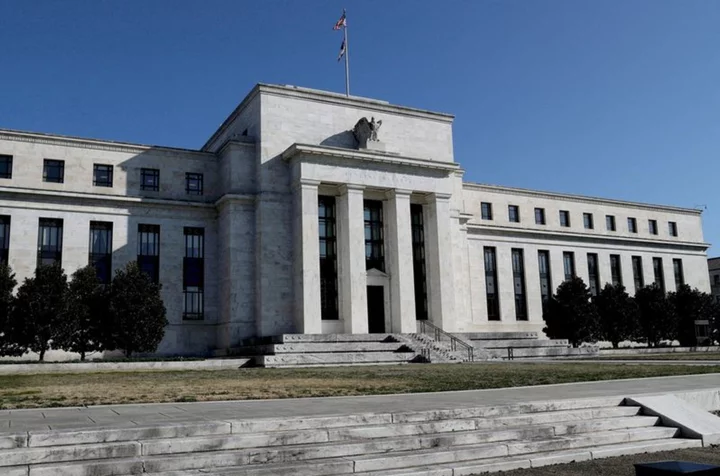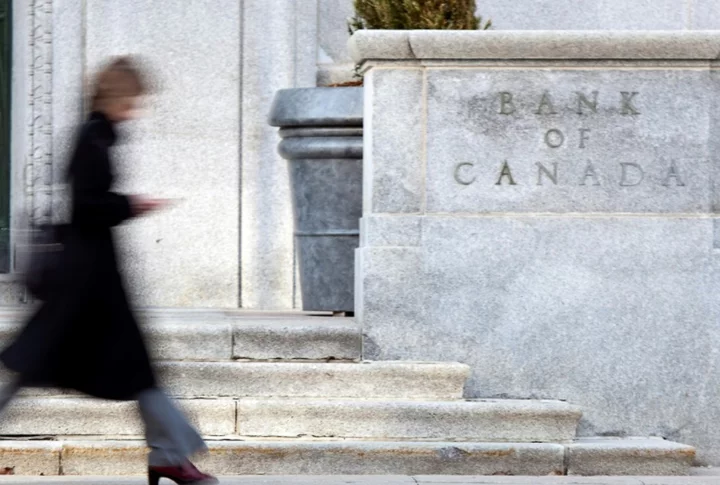U.S. banks tightened credit standards over the first months of the year and saw weakness in loan demand from businesses and consumers, Federal Reserve survey data released on Monday showed in the latest indication that higher central bank interest rates were starting to bite in the finance sector.
The Fed's quarterly Senior Loan Officer Opinion Survey, or SLOOS, among the first measures of sentiment across the banking sector since the recent run of bank failures, showed a net 46.0% of banks tightened terms of credit for a key category of business loans for medium and large businesses compared with 44.8% in the prior survey in January.
For small firms, conditions were slightly more stringent with a net 46.7% of banks saying credit terms were stiffer now vs 43.8% in the last survey.
Banks reported that firms of all sizes were showing less demand for credit than three months earlier.
On the consumer side, banks said soft demand prevailed again for credit card, automobile and other forms of household credit, although not to the degree seen at the end of last year. Banks on balance showed diminished willingness to provide consumer installment loans.
ADDED SIGNIFICANCE
The quarterly loan officer survey has taken on particular significance since the failure in early March of Silicon Valley Bank and the ongoing potential for stress among regional banks in general.
The Federal Reserve has been raising interest rates aggressively to control inflation since March of 2022, and a main way that works is by increasing the cost of borrowing money for businesses and households and discouraging major investments and purchases. The impact was felt quickly through things like rising home mortgage rates, and the last three SLOOS surveys, dating to the start of the rate hikes, have shown a rising net share of banks tightening standards.
But policymakers don't want the credit tightening to go so far as to cause a recession.
The Fed had the results of the latest survey in hand at its policy meeting last week, and while officials proceeded with an expected quarter point rate increase they also opened the door to calling it quits - with the effects of a possible credit shock still to be determined.
"The strains that emerged in the banking sector in early March appear to be resulting in even tighter credit conditions for households and businesses," Fed Chair Jerome Powell said in a press conference on Wednesday. "In turn, these tighter credit conditions are likely to weigh on economic activity, hiring, and inflation. The extent of these effects remains uncertain."
Asked specifically about the SLOOS, Powell said that banking data, the SLOOS results, and anecdotal information collected by Fed officials showed that while "lending has continued to grow...the pace has been slowing really since the second half of last year."
That's consistent with what economists are expecting in coming months, with the survey serving as a leading indicator of how bank credit is likely to evolve over time.
One closely watched survey response, for example, is the net share of banks tightening commercial loan standards for large and middle-sized firms. That rose from 24% for the survey covering the April through June period to 45% for the survey covering roughly the last three months of the year.
Economists who study the SLOOS responses say rising shares of banks tightening standards gradually work their way into slowed economic activity, and can even be a precursor to a downturn.
"Just like Fed hikes, there is a long and variable lag from the impact of tighter lending standards on the economy," Michael Kantrowitz, chief investment strategist with Piper Sandler & Co. wrote on Monday. The survey, with tightening standards a leading indicator of eventually falling loan volumes, has "historically helped determine whether a Fed tightening cycle leads to a hard or soft landing."
(Reporting by Howard Schneider, Ann Saphir and Dan Burns; Editing by Andrea Ricci)









